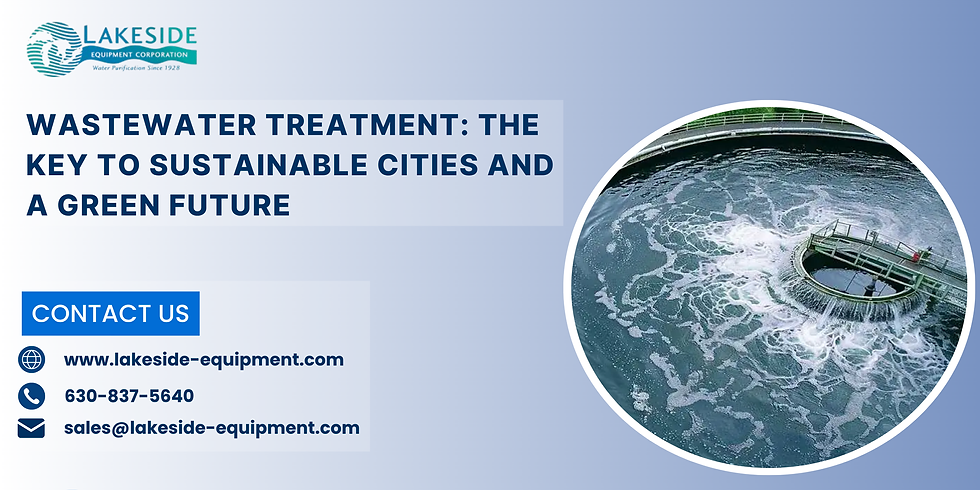Wastewater Treatment: The Key to Sustainable Cities and a Green Future
- lakesideequipment

- Jul 30, 2025
- 3 min read
As cities grow, the demand for clean water increases, and thus there is a challenge in managing wastewater. An important part of this wastewater can be treated and renovated, but effective treatment systems are necessary to maintain public health and protect the environment. One of the corners of wastewater treatment management in urban areas is the use of advanced waste treatment procedures.

These operations are not only about water cleaning, but also ensure that the resources used are durable, reduce energy use, and reduce environmental footprints. Whether wastewater bar screen or wastewater clarifiers, all units play an important role in reaching a permanent world.
Wastewater Treatment: The Unsung Hero of Urban Sustainability
In search of sustainable cities, wastewater treatment is often ignored despite its significant importance. Millions of gallons of wastewater is made from homes, businesses, and industries daily. If not treated, such wastewater will pollute the bodies, kill aquatic life, and spread diseases. This is why new wastewater remedies are very important - they help bring clean water back into the environment and avoid pollution.
The Role of Wastewater Bar Screens in Primary Treatment
Wastewater primary treatment starts with wastewater bar screens. They are massive metal grids used as the first line of defence in any treatment plant. Wastewater entering the plant usually carries trash like sticks, rags, and plastic, which clog equipment and interfere with treatment. The wastewater bar screen traps and discharges these items before the water proceeds further into the system.
These screens perform very well in avoiding expensive damage to downstream equipment and facilitating easy operation of the entire treatment process. The screens in most facilities are self-cleaning, either screen rotation or mechanically scraped, to avoid clogging. This assists in avoiding loss of efficiency and decreased frequency of manual maintenance.
Wastewater Screens: The First Step Toward Clean Water
After coarse debris has been eliminated by the bar screens, wastewater screens then filter out finer particles. Screens vary in types, ranging from coarse to fine by the treatment stage and type of wastewater. Wastewater screens serve to catch finer solids that would otherwise interfere with further treatment processes or contaminate the treated water quality.
These screens are mechanical or static, depending on the treatment plant's complexity. For example, the mechanical wastewater screens often tend to use a motorized system with which the screen is cleaned regularly when it is lifted or rotated, whereas static screens use gravity to allow the water to pass through the mesh as suspended solids filter off naturally. This filtering process is crucial in pre-treating wastewater for further advanced treatment, including biological treatment or chemical disinfection.
Advanced Treatment Technologies for a Green Future
In addition to explanations, treatment plants also employ more refined technologies such as biological filtration, chemical remedies and membrane technologies to eliminate contaminants such as nutrients (nitrogen and phosphorus) and to detect pollutants. These technologies increase the quality of water that can be safely returned to the environment or even used for non-affected applications such as irrigation or industrial cooling.
One of the thrilling developments is the idea of zero-parallel discharge systems, on which wastewater discharge is minimized up to zero to recycle almost all water and solid wastes. The ZLD water management has a heart direction towards the closure of loops, which will prove necessary because water resources in cities are faced due to increasing pressure.
Wastewater Clarifiers: Sedimentation of the Wastewater for Further Processing
Following the removal of solids using wastewater screens, wastewater then trickles to the wastewater clarifier. The wastewater clarifier is a big settling tank used to allow the suspended solids and sludge to sink to the bottom, separating heavier particles from lighter, cleaner water. This is referred to as primary clarification.
Clarifiers normally depend on gravity to drain out particulate matter from wastewater, thus making it a relatively inexpensive, energy-saving water quality improvement method. The bottom sludge is normally pumped out periodically and sent to a sludge treatment process, where the sludge can either be dewatered, digested, or even reclaimed for biogas utilization.
Conclusion
Wastewater treatment is never the most glamorous aspect of city infrastructure, but it's certainly one of the most critical. From wastewater bar screens that keep trash from piling up to wastewater clarifiers that send cleaner water back into the ecosystem. The more we continue to innovate and invest in green treatment technologies, the better we can plan cities not just up, but also in a manner that honours and sustains nature as well.
Lastly, wastewater treatment is not just about cleaning up water - it's about creating a green future for all of us, where cities thrive without destroying the world.




Comments